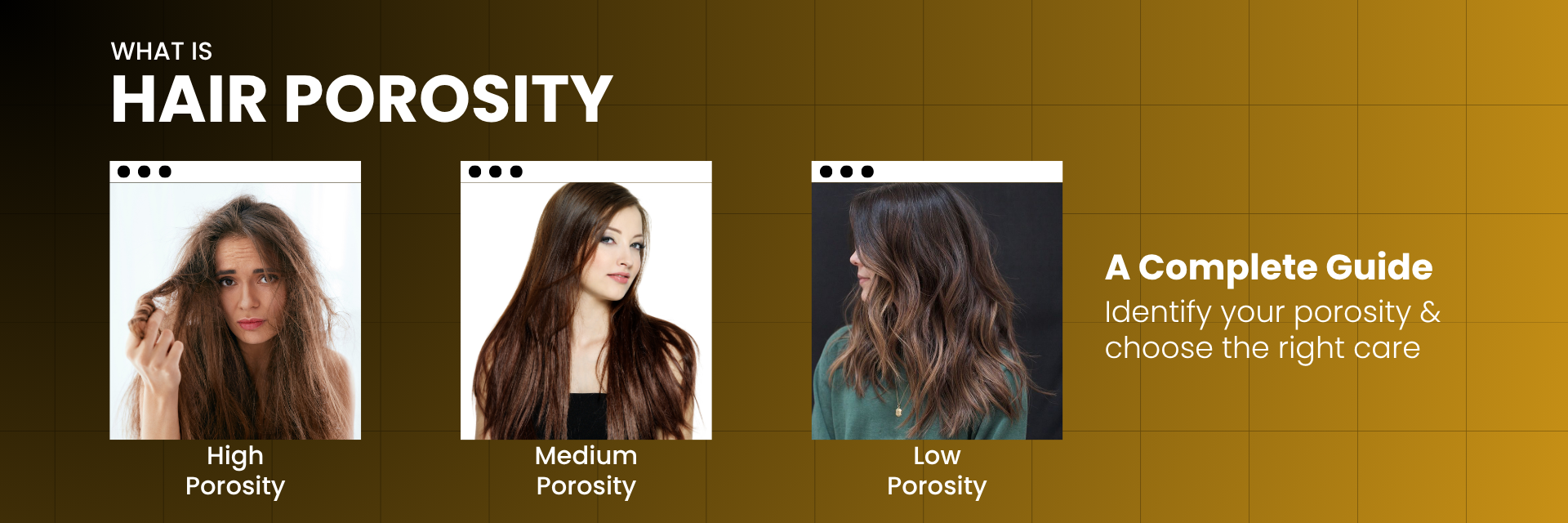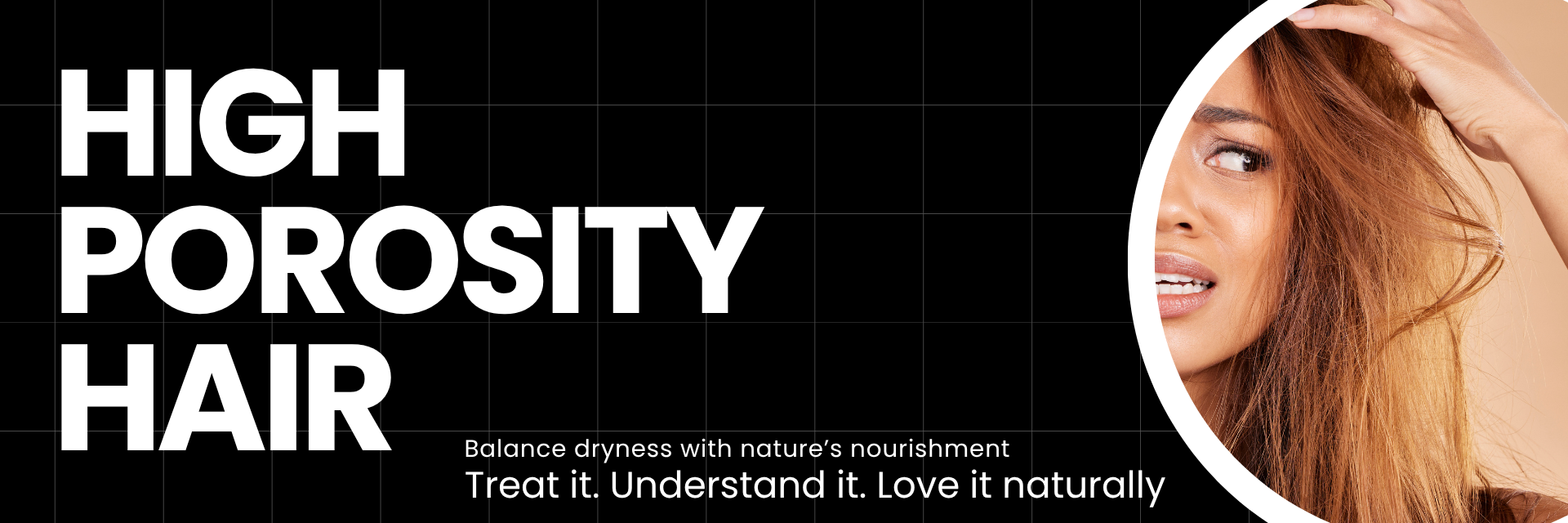What is Low Porosity Hair? A Complete Guide

Key Takeaways
-
What is Low Porosity Hair? It's a hair type with a tightly closed cuticle that resists moisture but holds it well once absorbed.
-
Symptoms: Signs include hair that takes a long time to get wet or dry, and products that tend to sit on the surface instead of absorbing.
-
Causes: Low porosity is a natural, genetic trait often associated with the Kapha dosha.
-
Hair Care Tips: To manage it, use warm water when washing, opt for lightweight, water-based products, and use gentle heat during deep conditioning to help with absorption.
-
Mistakes to Avoid: You should avoid using heavy oils and butters that cause product buildup and weigh your hair down.
-
The Right Solution: Choosing a routine with products specifically formulated for low porosity hair is key to achieving healthy, balanced hair.
Have you ever wondered why your hair takes a long time to get wet in the shower? Or why some products seem to just sit on your hair without soaking in? The answer to these common frustrations is all about low porosity hair. Understanding your hair porosity is the first step toward a routine that actually works.
In this guide, you will learn all about low porosity hair, its characteristics, and the best way to care for it for healthy, beautiful results.
To truly care for your hair, you first need to understand what low porosity is.
What is Low Porosity Hair?
Low porosity hair is a hair type that has a tightly packed cuticle layer. The cuticle is your hair’s outermost layer, made up of tiny, overlapping scales. In low porosity hair, these scales lie flat and are very close together. This compact structure makes it difficult for moisture, water, and products to enter the hair shaft.
Since the hair resists moisture, products can often build up on the surface of your hair rather than being absorbed. However, this same structure means that once moisture gets in, it is sealed inside, which helps your hair retain hydration for a long time.
Now that you know what low porosity hair is, let's look at the signs you can observe. Your hair's characteristics are a direct result of its porosity level.
What are the Characteristics of Low Porosity Hair?
Common symptoms of low porosity hair include hair that takes a long time to get fully wet, products sitting on the surface instead of absorbing, and buildup happening easily. You may also notice your hair feels dry even after using moisturizing products, takes longer to air-dry, and resists chemical treatments or colouring.
We’ll discuss them in detail now.
-
Your hair takes a long time to get wet
When you wash your hair, you may notice that the water seems to bead on the surface for a while before your hair becomes fully saturated. It can feel like your hair is resisting the water. This happens because the hair cuticle is tightly closed, which prevents moisture from being absorbed quickly. You may have to spend extra time in the shower to make sure all of your hair is completely wet.
-
Your hair takes a long time to air dry
Once your hair is finally wet, the tightly sealed cuticle prevents the moisture from leaving the hair shaft quickly. This results in very long air-drying times. Your hair may still feel damp for several hours after washing, which can make air-drying difficult or impractical. This characteristic is a direct result of your hair's excellent ability to hold onto moisture.
-
Products sit on top of your hair
Heavy products and oils can sit on the surface of your hair, leaving it feeling greasy, waxy, or coated. This is because the molecules in these products are too large to pass through the tightly closed cuticle. This can cause significant product buildup on your hair and scalp, which can block new moisture from being absorbed.
-
Your hair can look dull or lack volume
Since products do not get absorbed easily, your hair may not be getting the deep nourishment it needs to look shiny. Instead of penetrating the hair shaft, products sit on the surface, which can lead to a limp or flat appearance. The buildup can weigh your hair down, which is why it can lack volume.
Once you can recognize the signs of low porosity hair, you might wonder why your hair is like this. The answer lies in its core makeup and a few key factors.
Why Is Your Hair Low Porosity?
The main reason you have low porosity hair is genetics. It is a natural trait passed down from your family. While other factors like heat damage can temporarily change hair porosity over time, low porosity is typically your hair’s natural, healthy state.
In the ancient Indian system of Ayurveda, this hair type is often connected to the Kapha dosha, which is associated with traits like being thick, strong, and sometimes oily. Your hair is naturally resistant and resilient, and the right care routine will help you work with this natural strength.
Understanding the "why" is important, but now let's focus on the "how." Caring for your hair according to its porosity is all about using the right products and techniques for its unique needs.
What are the Best Tips for Low Porosity Hair Care?
The best tips for low porosity hair care are to use warm water when washing to open up the cuticles, stick to lightweight and water-based products that absorb easily, and avoid heavy oils or butters that just sit on the hair.
Regularly use a water-based shampoo to prevent buildup and allow moisture in. Deep conditioning with heat also helps products penetrate better, while applying products on damp, not soaking wet, hair ensures they work more effectively.
Read on if you wish to know how to take care of low porosity hair in detail.
-
Cleansing
Start with Warm Water
Begin your wash routine by rinsing your hair with warm water. The warmth helps gently lift the hair cuticles, which is especially important for low porosity hair since its cuticles tend to stay tightly closed. By slightly opening them, shampoo and conditioner can penetrate more effectively to make cleansing and hydration much easier.
Choose a Lightweight Shampoo
Always go for a water-based, lightweight shampoo instead of heavy or creamy formulas. Low porosity hair can easily accumulate residue, and thicker shampoos may just sit on the surface without truly cleansing. A lightweight shampoo ensures your scalp is refreshed and your strands are properly cleaned without leaving behind buildup.
Prevent Product Buildup
Over time, styling products and even conditioners can leave a thin layer of residue on low porosity hair. To prevent dullness and heaviness, use a water-based shampoo once a month. This type of shampoo cleanses your scalp by penetrating the cuticles and offering the much needed moisture. It prevents stubborn buildup, maintains your hair’s natural shine, and makes it more receptive to moisture.
Add Hydration with Steam
Steam is a natural friend for low porosity hair. While conditioning, let the steam from your shower create a moist, warm environment around your hair. This helps soften the cuticles further and allows the conditioner to sink in more deeply, providing a boost of hydration that regular rinsing alone cannot achieve.
-
Conditioning
Use Lightweight Conditioners
Just like with shampoo, lightweight and water-based conditioners are the best match for low porosity hair. They provide essential moisture while avoiding the heaviness that comes with thick, creamy products, which can leave hair looking greasy or flat instead of refreshed and soft.
Deep Condition with Heat
For maximum benefit, pair your conditioner with gentle heat, such as a warm towel or hooded dryer. The heat encourages the hair cuticles to lift slightly, allowing the conditioner to penetrate deeper into the strands. This results in longer-lasting softness and hydration, making your hair more manageable.
Limit Protein Treatments
While protein treatments are beneficial for strengthening hair, too much protein in low porosity hair can cause the strands to feel stiff, brittle, and even prone to breakage. It’s best to use them occasionally rather than frequently, and always follow with proper moisture to keep hair balanced.
Avoid Heavy Oils and Butters
Low porosity hair doesn’t absorb heavy products easily. Oils like castor or butters like shea often just coat the surface, leaving behind a greasy or sticky feeling. Instead, stick to lightweight oils and skip heavy butters altogether to avoid product buildup that prevents real hydration from getting through.
-
Styling
Apply Products to Damp Hair
After washing, avoid applying products to soaking wet hair. Instead, gently blot excess water using a microfiber towel, which reduces frizz and breakage compared to regular towels. Styling on slightly damp hair helps products absorb better and prevents them from simply sliding off.
Stick to Lightweight Formulas
When styling low porosity hair, opt for products with a lighter texture, such as leave-in sprays, gels, or lightweight creams. These formulas absorb more easily into your strands, reducing the risk of buildup while still providing the hold, moisture, and definition your hair needs.
Follow the LOC Method
One of the most effective routines for low porosity hair is the LOC method—Liquid, Oil, Cream. Start with a water-based liquid, like a hydrating leave-in conditioner, to add moisture. Then apply a light oil, such as argan or grapeseed, to lock in that hydration without being too heavy. Finally, finish with a lightweight cream to seal everything in and keep your hair hydrated for longer.
Layer Moisture for Lasting Results
The secret to managing low porosity hair is layering moisture in the right order. Each step of the LOC method works together to ensure that hydration not only enters the hair but also stays locked in. This keeps your hair soft, manageable, and healthy without the weight or buildup that comes from heavier products.
Here is a YouTube video that explains how to care for low porosity hair.
Even with the best routine, it is easy to make mistakes. Knowing what to avoid is just as important as knowing what to do.
What are the Common Mistakes to Avoid with Low Porosity Hair?
Even with the right products, you can make mistakes that harm your hair. Knowing these common errors can help you perfect your routine.
-
Using Too Much Product
A little goes a long way with low porosity hair. Applying too much product will only cause buildup and leave your hair feeling greasy and limp. Start with a small amount and add more only if needed. Overloading your strands can actually block out the moisture you’re trying to add, making your hair harder to manage. Always remember that layering lightweight products is more effective than piling on heavy ones.
-
Using Cold Water
Rinsing with cold water can close the hair cuticle, which is not what you want. You should use warm water throughout your wash to help your hair absorb moisture. Cold rinses lock out hydration, leaving your hair less receptive to treatments. Warm water, on the other hand, ensures conditioners and masks penetrate effectively, giving your strands the nourishment they need.
-
Over-Moisturizing
While moisture is important, overdoing it can cause more problems. You should only moisturize as needed and avoid products that are too thick or heavy. Excess moisture without balance can leave your hair feeling mushy or overly soft, making it more prone to breakage. To avoid this, always balance hydration with proper cleansing and light protein treatments when necessary.
With all this information, finding the right products might still seem confusing. Fortunately, Prakruth Care has a solution that is made specifically for you.
Why is Prakruth Care Your Solution for Low Porosity Hair?
Prakruth Care's products are formulated with your unique hair type in mind. Our Low Porosity Shampoo & Conditioner were created to directly address the needs of low porosity hair. Our water-based formulas are the first in India and offer numerous benefits. They are lightweight and work to cleanse and hydrate without adding unnecessary heaviness.
They are a perfect example of our Ayurvedic philosophy, which focuses on providing your hair with the exact nourishment it needs. By choosing our products, you are choosing a solution that works in harmony with your hair's natural properties.
-
Low Porosity Shampoo & Conditioner Combo

For a complete routine, you can use our Low Porosity Hair Products combo. This set includes both our premium shampoo and conditioner, which are designed to work together to give you the best results for your low porosity hair.
-
Herbal Low Porosity Shampoo

Our Herbal Low Porosity Shampoo is a specially created, water-based formula that revitalizes dull, sticky, and thin hair. It gently cleanses and nourishes without adding unnecessary heaviness.
-
Herbal Low Porosity Conditioner

Our Herbal Low Porosity Conditioner is also a water-based formula. It's designed to provide deep moisture and help with detangling without leaving a greasy or heavy residue.
Conclusion
Understanding low porosity hair is the first step toward a routine that truly works. You now know its characteristics and the common mistakes to avoid. By choosing the right products and care techniques, you can transform your hair's health. Taking these simple steps empowers you to work with your hair's natural properties, not against them.
Ready to start your journey to a healthier scalp and more beautiful hair? Explore Prakruth Care's low porosity product line today.
Frequently Asked Questions for Low Porosity Hair
How to grow low porosity hair?
The key to growing low porosity hair is maintaining a healthy, clean scalp. You must use lightweight, water-based products that will not cause buildup. When buildup is removed, hair follicles are not clogged, which helps to support healthy hair growth. Regular gentle cleansing and proper moisturization are the best ways to support your hair's growth.
How do you moisturize low porosity hair?
You moisturize low porosity hair by helping moisture get past the tight cuticle. The best way to do this is to use warm water and a lightweight, water-based conditioner. The warm water helps to gently lift the cuticle, allowing the moisture to get in. After conditioning, you can apply a light leave-in product to seal in the hydration.
Why am I getting acne or a red scalp with low porosity hair?
It's common for people with low porosity hair to experience scalp issues like acne, redness, and itchiness. This often happens because products sit on the scalp instead of absorbing. The unabsorbed products can clog your hair follicles and pores, leading to scalp acne and irritation. To avoid this, use lightweight, water-based products and make sure to wash them out thoroughly.
Does low porosity hair cause hair fall?
Low porosity hair itself does not directly cause hair fall. However, the product buildup that is common with this hair type can lead to a blocked scalp. Clogged hair follicles can weaken your hair's roots and prevent new hair growth, which can make it seem like you are experiencing hair fall. Regularly using a clarifying shampoo can help remove this buildup and support a healthy scalp.
Why is my hair always flat and lacks volume?
Low porosity hair often lacks volume because of product buildup. When products sit on the hair's surface, they can weigh down your strands, making your hair look limp and flat. Using lightweight formulas and avoiding heavy oils and butters will help you maintain your hair's natural bounce and volume.


